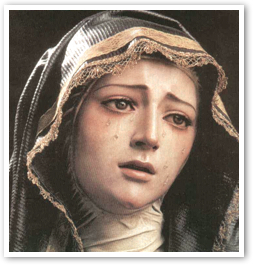The Feast of Our Lady of Sorrows
- FR. WILLIAM SAUNDERS
In September we celebrated the feast of Our Lady of Sorrows. Would you please explain for me this feast and its origin?
 The title, Our Lady of Sorrows, given to our Blessed Mother focuses on her intense suffering and grief during the passion and death of our Lord. Traditionally, this suffering was not limited to the passion and death event; rather, it comprised the seven dolors or seven sorrows of Mary, which were foretold by the Priest Simeon who proclaimed to Mary, This child [Jesus] is destined to be the downfall and the rise of many in Israel, a sign that will be opposed and you yourself shall be pierced with a sword so that the thoughts of many hearts may be laid bare (Luke 2:34-35). These seven sorrows of our Blessed Mother included the flight of the Holy Family into Egypt; the loss and finding of the child Jesus in the Temple; Mary's meeting of Jesus on His way to Calvary; Mary's standing at the foot of the cross when our Lord was crucified; her holding of Jesus when He was taken down from the cross; and then our Lord's burial. In all, the prophesy of Simeon that a sword would pierce our Blessed Mother's heart was fulfilled in these events. For this reason, Mary is sometimes depicted with her heart exposed and with seven swords piercing it. More importantly, each new suffering was received with the courage, love, and trust that echoed her fiat, let it be done unto me according to Thy word, first uttered at the Annunciation.
The title, Our Lady of Sorrows, given to our Blessed Mother focuses on her intense suffering and grief during the passion and death of our Lord. Traditionally, this suffering was not limited to the passion and death event; rather, it comprised the seven dolors or seven sorrows of Mary, which were foretold by the Priest Simeon who proclaimed to Mary, This child [Jesus] is destined to be the downfall and the rise of many in Israel, a sign that will be opposed and you yourself shall be pierced with a sword so that the thoughts of many hearts may be laid bare (Luke 2:34-35). These seven sorrows of our Blessed Mother included the flight of the Holy Family into Egypt; the loss and finding of the child Jesus in the Temple; Mary's meeting of Jesus on His way to Calvary; Mary's standing at the foot of the cross when our Lord was crucified; her holding of Jesus when He was taken down from the cross; and then our Lord's burial. In all, the prophesy of Simeon that a sword would pierce our Blessed Mother's heart was fulfilled in these events. For this reason, Mary is sometimes depicted with her heart exposed and with seven swords piercing it. More importantly, each new suffering was received with the courage, love, and trust that echoed her fiat, let it be done unto me according to Thy word, first uttered at the Annunciation.
This Feast of Our Lady of Sorrows grew in popularity in the 12th century, although under various titles. Granted, some writings would place its roots in the eleventh century, especially among the Benedictine monks. By the fourteenth and fifteenth centuries, the feast and devotion were widespread throughout the Church.
Interestingly, in 1482, the feast was officially placed in the Roman Missal under the title of Our Lady of Compassion, highlighting the great love our Blessed Mother displayed in suffering with her Son. The word compassion derives from the Latin roots cum and patior which means to suffer with. Our Blessed Mother's sorrow exceeded anyone else's since she was the mother of Jesus, who was not only her Son but also her Lord and Savior; she truly suffered with her Son. In 1727, Pope Benedict XIII placed the Feast of Our Lady of Compassion in the Roman Calendar on Friday before Palm Sunday. This feast was suppressed with the revision of the calendar published in the Roman Missal of 1969.
In 1668 the feast in honor of the Seven Dolors was set for the Sunday after September 14, the Feast of the Holy Cross. The feast was inserted into the Roman calendar in 1814, and Pope Pius X fixed the permanent date of September 15 for the Feast of the Seven Sorrows of the Blessed Virgin Mary (now simply called the Feast of Our Lady of Sorrows). The key image here is our Blessed Mother standing faithfully at the foot of the cross with her dying Son: the Gospel of St. John recorded, Seeing His mother there with the disciple whom He loved, Jesus said to His mother, 'Woman, there is your son.' In turn He said to the disciple, 'There is your mother.' (John 19:26-27). The Second Vatican Council in its Dogmatic Constitution on the Church wrote, A...She stood in keeping with the divine plan, suffering grievously with her only-begotten Son. There she united herself, with a maternal heart, to His sacrifice, and lovingly consented to the immolation of this Victim which she herself had brought forth (#58).
St. Bernard (d. 1153) wrote, Truly, O Blessed Mother, a sword has pierced your heart.... He died in body through a love greater than anyone had known. She died in spirit through a love unlike any other since His (De duodecim praerogatativs BVM).
Focusing on the compassion of our Blessed Mother, our Holy Father, Pope John Paul II, reminded the faithful, Mary Most Holy goes on being the loving consoler of those touched by the many physical and moral sorrows which afflict and torment humanity. She knows our sorrows and our pains, because she too suffered, from Bethlehem to Calvary. 'And thy soul too a sword shall pierce.' Mary is our Spiritual Mother, and the mother always understands her children and consoles them in their troubles. Then, she has that specific mission to love us, received from Jesus on the Cross, to love us only and always, so as to save us! Mary consoles us above all by pointing out the Crucified One and Paradise to us! (1980).
Therefore, as we honor our Blessed Mother, our Lady of Sorrows, we honor her as the faithful disciple and exemplar of faith. Let us pray as we do in the opening prayer of the Mass for this feast day: Father, as your Son was raised on the cross, His Mother Mary stood by Him, sharing His sufferings. May your Church be united with Christ in His suffering and death and so come to share in His rising to new life. Looking to the example of Mary, may we too unite our sufferings to our Lord, facing them with courage, love, and trust.
 This is J. Fraser Field, Founder of CERC. I hope you appreciated this piece. We curate these articles especially for believers like you.
This is J. Fraser Field, Founder of CERC. I hope you appreciated this piece. We curate these articles especially for believers like you.
Please show your appreciation by making a $3 donation. CERC is entirely reader supported.

Acknowledgement
Saunders, Rev. William. The Feast of Our Lady of Sorrows. Arlington Catholic Herald.
Reprinted with permission of the Arlington Catholic Herald.
The Author

 Father William Saunders is pastor of Our Lady of Hope parish in Potomac Falls, Virginia. He is dean of the Notre Dame Graduate School of Christendom College. The above article is a "Straight Answers" column he wrote for the Arlington Catholic Herald. Father Saunders is the author of Straight Answers, a book based on 100 of his columns, and Straight Answers II.
Father William Saunders is pastor of Our Lady of Hope parish in Potomac Falls, Virginia. He is dean of the Notre Dame Graduate School of Christendom College. The above article is a "Straight Answers" column he wrote for the Arlington Catholic Herald. Father Saunders is the author of Straight Answers, a book based on 100 of his columns, and Straight Answers II.


